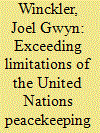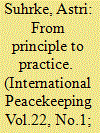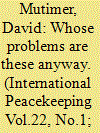|
|
|
Sort Order |
|
|
|
Items / Page
|
|
|
|
|
|
|
| Srl | Item |
| 1 |
ID:
137133


|
|
|
|
|
| Summary/Abstract |
United Nations peacekeeping is implemented by a complex bureaucratic organization, which itself can be a source of dysfunction and failure. This article empirically explores the strategies officials within the United Nations Mission in Liberia and the Department of Peacekeeping Operations apply in order to continue to do their job as effectively as possible despite the limitations of the UN peacekeeping bureaucracy. The findings demonstrate that internal acknowledgement and relevance of work are core strategic goals of UN officials. However, as the actual practices of achieving these objectives vary at different levels and locations of the UN peacekeeping bureaucracy, these strategies contribute to a significant diversity of local and decentralized decision-making frameworks rather than a rationalized effective bureaucracy.
|
|
|
|
|
|
|
|
|
|
|
|
|
|
|
|
| 2 |
ID:
137137


|
|
|
|
|
| Summary/Abstract |
In this study, the motivation behind South Korea's active participation in UN peacekeeping operations is examined. Specifically, whether its participation is driven by economic, political or normative considerations is explored. The argument made here is that a normative consideration is the main factor behind Korea's participation in UN peacekeeping operations. The example of Korea illustrates that not only economic and political considerations but also normative concerns are among the national interests that drive countries to engage in issues of human rights violations in the international community.
|
|
|
|
|
|
|
|
|
|
|
|
|
|
|
|
| 3 |
ID:
137142


|
|
|
|
|
| Summary/Abstract |
During its engagement in Afghanistan, the US military seriously tried to mitigate the risk of civilian casualties from airstrikes only when called for by changes in military doctrine emphasizing the need to gain the support of the population. Consistent efforts by external political and humanitarian actors to reduce casualties by demanding more transparency and clearer lines of accountability for ‘collateral damage’ had little immediate, observable effect. The case study underlines the contingent nature of progress towards protecting civilians in armed conflict even when a military institution formally accepts the principles of customary international humanitarian law, but concludes that, faute de mieux, strategies to enhance protection through greater accountability and attention to the kind of military ordinance used remain central.
Over time there have been significant advances in international humanitarian law to strengthen the protection of civilians during armed conflict, and, as Adam Roberts notes, ‘in practice something has been achieved’.1 The record of the US military forces in Afghanistan after 2001, however, underlines the element of contingency in this development. During more than a decade of combat engagement in Afghanistan, the US military operated in a context of customary international law that was formally observed, but measures to reduce the impact of military operations on civilians varied significantly in practice. Only in two short periods did the USA or joint ISAF (International Security Assistance Force) command adopt practices to seriously mitigate the risk of civilian casualties. What explains this variation over time, and what does it tell us about the influence of legal norms on the belligerent?
Civilian casualties produced by US airstrikes produced the vast majority of casualties attributed to allied operations in Afghanistan. Authoritative sources reported almost 2,000 were killed and many more injured in the period 2006–13 (see Table 1).2 The US military and ISAF considered the civilian deaths as incidental damage – the unfortunate, accidental effects of war. Yet as Neta Crawford has argued, these effects were systemic in nature.3 They were ‘normal accidents’ in the sense originally developed by Charles Perrow: the predictable outcome of a flawed system design.4
|
|
|
|
|
|
|
|
|
|
|
|
|
|
|
|
| 4 |
ID:
137132


|
|
|
|
|
| Summary/Abstract |
Natural resources represent both peril and promise for peacebuilding. Natural resources can support economic recovery and sustainable livelihoods, and contribute to trust and cooperation frequently lacking in war-torn societies. Natural resources can also catalyse social disputes and provide revenue for would-be insurgents. Recognition that natural resources can be an opportunity and challenge for peace has led international peacebuilders to intervene in post-conflict countries to establish governance reforms that promote sustainable peace and development. This article examines international efforts to govern natural resources in the aftermath of conflict. Specifically, it focuses on Liberia, where timber was recognized as a key factor in fuelling the decade-long civil war; and as a result, forest reform was a peacebuilding priority. I argue that although there have been some positive results, the forest reform process has been controversial in part due to international interventions that mirror pre-war forest governance arrangements in which patronage and corruption historically took root and work to rekindle past sources of tension. I suggest that international peacebuilders should not see themselves as interveners but conveners that use natural resource governance as a way to build confidence and serve as a foundation for cooperation and peace.
|
|
|
|
|
|
|
|
|
|
|
|
|
|
|
|
| 5 |
ID:
137128


|
|
|
|
|
| Summary/Abstract |
Roland Paris is one of those authors whose work is always enjoyable, as he exploits so well the gap between the policy world and academia. His best work reveals a high level of policy insight often before many of his colleagues in academia have caught up. His secret is an ability to analyse the shifting understandings at policy level and to then to articulate them in academic terms as if critiquing current policies. This enables his work to be both popular with policy-makers and with their erstwhile critics in academia. His 2004 monograph, At War's End,1 captured the shift from peacekeeping intervention and ‘early exit’ to the extended remits of international statebuilding (‘Institutionalization before Liberalization’). It provided a wonderful rationalization of policy shifts that had already occurred in the late 1990s, starting with the extension of international mandates in Bosnia, from 1996 onwards, and further developed with the Kosovo protectorate in 1999. However, this shift was skilfully reposed as a critique of existing policy-understandings.
|
|
|
|
|
|
|
|
|
|
|
|
|
|
|
|
| 6 |
ID:
137131


|
|
|
|
|
| Summary/Abstract |
Roland Paris is a formidable intellectual, one of Canada's foremost mid-career scholars with an enviable international reputation already, who thinks deeply and writes cogently on some pressing contemporary challenges of global governance at the intersection of scholarship and policy – as well as a friend and professional colleague. That I am no longer able to interact with him as easily as when I was based in Canada is a keenly felt loss. This article highlights many of his impressive strengths as an analytical scholar on policy relevant topics.
Before responding to points with which I disagree, let me begin with some preliminary remarks. First, the responsibility to protect (R2P) is not a principle/norm in search of a self-validating crisis. Rather, it is an attempt to find new consensus on a rare but recurring problem, namely humanitarian atrocities which, in the age of an internationalized human conscience, are an increasing affront to modern sensibility for a growing number of people and countries.
|
|
|
|
|
|
|
|
|
|
|
|
|
|
|
|
| 7 |
ID:
137140


|
|
|
|
|
| Summary/Abstract |
In the post-cold war era, liberal statebuilding interventions have become a major tool of global governance. Yet, the variation in outcomes is still poorly understood. This article draws on state formation theory to elaborate a causal mechanism that can explain the successful monopolization of the means of violence in statebuilding interventions. Insights from the state formation literature suggest that the regional political system is crucial for state formation and statebuilding. In order to test the hypothesis, a novel process-tracing method is applied to the case of Sierra Leone. The case study suggests that only a cooperative regional setting enables interventions to succeed
|
|
|
|
|
|
|
|
|
|
|
|
|
|
|
|
| 8 |
ID:
137130


|
|
|
|
|
| Summary/Abstract |
In his article, Roland Paris identifies five insurmountable structural problems of preventative humanitarian intervention and that my Pragmatic Standard (as well as others) do little to remedy them.1 His ‘structural problems’, however, are only insurmountable because he has defined them as such. As a result, his criticism of my argument is off the mark.
Paris initially credits that my Pragmatic Standard's three pillars – (1) an ‘ongoing campaign of mass homicide’; (2) a ‘viable plan of intervention’, including an expectation of ‘near zero’ casualties among the interveners; and (3) a ‘workable strategy for creating lasting security, so that saving lives in the short team does not lead to open-ended chaos’,2 with many more killed in the longer term – are helpful. He objects, however, that the pillars still lead to three problems: first, creation of a moral hazard; second, insufficient time for preventive action; and third, lack of certainty that future atrocities would occur without intervention.
|
|
|
|
|
|
|
|
|
|
|
|
|
|
|
|
| 9 |
ID:
137129


|
|
|
|
|
| Summary/Abstract |
It has been more than 30 years since Robert Cox introduced the distinction between problem solving and critical theory to the study of international relations.1 To remind us, Cox took problem-solving theory to be that which ‘takes the world as it finds it, with the prevailing social and power relationships into which they are organized, as the given framework for action. The general aim of problem-solving is to make these relationships and institutions work more smoothly by dealing effectively with particular sources of trouble.’2 There is nothing necessarily wrong with solving problems, but it does tend to mask the ‘larger picture of the whole of which the initially contemplated part is just one component’, which critical theory leads us towards.3 I was reminded of Cox's work in reading Roland Paris’ analysis of the structural problems of R2P, because it is a masterful example of problem solving at its best, which at the same time begs us to take Cox's critical turn and look to the larger structures of which R2P and humanitarian intervention more particularly are a part.4 I would argue that the five structural problems Paris identifies are not features of humanitarian intervention, but rather of these larger structures within which the practice of intervention is embedded. In this short intervention I will defend this assertion, and then consider what difference it might make.
|
|
|
|
|
|
|
|
|
|
|
|
|
|
|
|
|
|
|
|
|